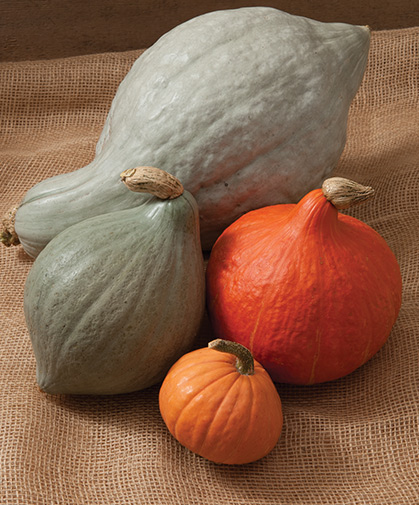Hubbard Winter Squash - Key Growing Information

SCIENTIFIC NAME:
Cucurbita maximaCULTURE:
Fertile, well-drained soil with a pH of 6.0–6.8 is best. Plastic mulch and fabric row covers (AG-19 grade) can aide plant establishment and exclude insect pests during the seedling stage. Row covers should be removed when plants begin to flower. Poor fruit development may indicate insufficient pollination.TRANSPLANTING:
Sow 2–3 seeds per 2" container or plug flat about 3 weeks prior to transplanting. Thin to 1 plant/container or cell with scissors. Harden plants 4–7 days prior to transplanting. After danger of frost has passed, transplant out according to the spacing recommendations for each variety. Handle seedlings carefully; minimal root disturbance is best.DIRECT SEEDING:
Sow 2 seeds at the appropriate spacing interval for the variety's vine length, 1/2–1" deep. Thin to 1 plant per spacing interval after seedlings are established.PLANT SPACING:
Bush to short-vine habits generally require 6' between-row spacing, while long-vine habits require 12' between-row spacing. In-row spacing depends on fruit size and is generally: small, 18–24"; medium, 24–36"; large, 36–48".DISEASES:
Common cucurbit diseases include powdery mildew, downy mildew, bacterial wilt, and Phytophthora. Avoid problems with adequate soil drainage, good air flow, insect pest control, and crop rotation. If necessary, check with your local Cooperative Extension Service agent for specific control options. INSECT PESTS:
Cucumber beetles, squash bugs, and vine borers are all common pests for cucurbits. Protect young plants with floating row cover. Squash bug eggs found on the undersides of leaves may be crushed by hand. For vine borers, cut out of vines and hill soil over the wound. Keep field borders mowed and remove plant refuse in the fall; spring plow to bury pupae. Pyrethrin sprays may offer some control.HARVEST:
Fruits are typically ready about 50–55 days after fruit set, and should be harvested before any hard frosts. Cut fruits from vines and handle carefully. Sun cure by exposing fruits for 5–7 days or cure indoors by keeping squash at 80–85°F/27–29°C with good air ventilation.STORAGE:
Store at 50–60°F/10–15°C, 50–70% relative humidity and good ventilation. Repeated exposure to temperatures below 50°F/10°C may cause chilling damage. Hubbards are better after a few weeks in storage and will keep up to 6 months. Red Kuri is the exception in that it is delicious right out of the field, but will only last a maximum of 3 months.DAYS TO MATURITY:
From direct seeding; subtract about 14 days if transplanting.AVG. DIRECT SEEDING RATES:
(At 2 seeds/ft., rows 6' apart.) 1 oz./50', 1 lb./850', 8½ lb./acre. SEED SPECS:
See individual varieties.PACKET:
30 seeds.


